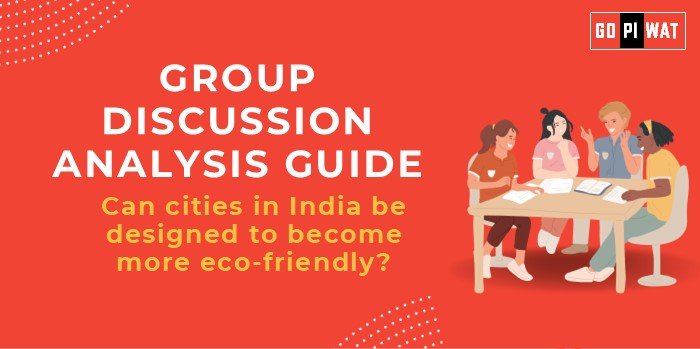📋 Group Discussion (GD) Analysis Guide: Can cities in India be designed to become more eco-friendly?
🌐 Introduction to the Topic
Context Setting
India is rapidly urbanizing, with over 35% of its population living in cities, a figure projected to exceed 50% by 2050. This urban growth necessitates sustainable development to combat climate change and ensure quality of life.
Background
Eco-friendly cities, often referred to as “green cities,” focus on sustainable urban planning, energy efficiency, waste management, and inclusive growth. Globally, cities like Copenhagen and Singapore set benchmarks in eco-friendly urban living.
📊 Quick Facts and Key Statistics
- 🏙️ Urban Population: 483 million (2023) – Highlighting the scale of urban challenges.
- 🌍 CO2 Emissions Contribution: 70% from cities globally – Cities are critical in climate strategies.
- 🌱 Green Spaces: Only 3% of urban areas in India meet WHO’s recommendation of 9 m² per capita.
- 🚮 Waste Management: India generates 62 million tons of municipal waste annually, with only 20% processed.
🤝 Stakeholders and Their Roles
- 🏛️ Government Agencies: Enforce green building norms, promote renewable energy, and fund eco-initiatives.
- 🏢 Urban Local Bodies: Develop and manage infrastructure like public transport and waste systems.
- 🚴♀️ Citizens and NGOs: Advocate and adopt sustainable practices like recycling and eco-friendly commuting.
- 💼 Private Sector: Innovate in sustainable technologies and partner in smart city projects.
🏆 Achievements and Challenges
Achievements
- 🏢 Green Building Growth: India has the second-largest number of LEED-certified buildings globally.
- ☀️ Renewable Energy Expansion: Solar rooftop installations in urban areas increased by 80% in five years.
- 🚇 Mass Transit Development: Metro networks now span 15 cities, reducing urban congestion.
Challenges
- 🚱 Resource Scarcity: Lack of clean water and inefficient energy use.
- 🚮 Waste Management: Limited recycling and hazardous landfill reliance.
- 🏚️ Inequitable Growth: Urban planning often neglects low-income groups.
Global Comparisons
- 🇩🇰 Copenhagen: Carbon-neutral goals by 2025 through wind energy and biking.
- 🇸🇬 Singapore: Advanced vertical farming and efficient waste recycling systems.
Case Studies
- 🇮🇳 Indore, India: Successfully implemented a door-to-door waste collection system, winning “Cleanest City” awards.
📂 Structured Arguments for Discussion
- 🟢 Supporting Stance: “Eco-friendly urban planning is no longer optional; it is imperative for India’s sustainable future.”
- 🔴 Opposing Stance: “Retrofitting Indian cities for sustainability is expensive and faces systemic resistance.”
- ⚖️ Balanced Perspective: “While eco-friendly initiatives are critical, success depends on stakeholder collaboration and inclusivity.”
📖 Effective Discussion Approaches
Opening Approaches
- 🌍 Data Start: “With cities contributing 70% of global emissions, eco-friendly urban planning is a vital climate solution.”
- 🏆 Success Example: “Indore’s waste management system highlights the feasibility of urban sustainability projects.”
Counter-Argument Handling
- ✔️ Cost Concerns: Emphasize long-term savings and global benchmarks for feasibility.
- 💡 Alternatives: Highlight public-private partnerships and community-driven initiatives.
🔍 Strategic Analysis of Strengths and Weaknesses
- ✅ Strengths: Strong policy frameworks (e.g., Smart Cities Mission), growing renewable energy capacity.
- ❌ Weaknesses: Lack of enforcement, urban sprawl.
- 🌟 Opportunities: Smart technologies, public-private partnerships.
- ⚠️ Threats: Political inertia, public apathy.
📚 Connecting with B-School Applications
- 💡 Real-World Applications: Green finance, supply chain optimization, and urban sustainability metrics.
- 📝 Sample Interview Questions:
- “What urban planning practices can Indian cities adopt from global leaders?”
- “How can green finance drive eco-friendly city development?”
- 📖 Insights for Students:
- Build expertise in sustainability metrics.
- Analyze urban policies.
- Explore green entrepreneurship opportunities.


